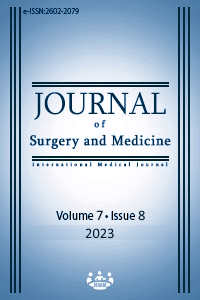Heavy metals in human bones from the Roman Imperial Period
Public health problem in the Roman Empire: Heavy metals
Keywords:
bone, anatomy, heavy metalsAbstract
Background/Aim: Heavy metals are elements known for their toxic effects even at low concentrations, and human exposure to these elements spans history. This study aimed to investigate trace element levels in the bones of individuals from the Roman Imperial Period. The objectives were to determine the values of specific metals, including heavy metals, make a rough comparison with present-day values, and gain insights into the environmental conditions of that era.
Methods: Due to the use of dry bone samples, ethical committee approval was not required for this research. The study analyzed element levels in human bones dated back to the Roman Imperial Period (218-244 AD), unearthed in 2018 during excavations in Turkey-Kayseri. Only bones that archaeologists verified to belong to the specified period were included, while those with uncertain origins were excluded. The samples were taken from os coxae of 15 individuals (eight males and seven females) to analyze Ca, P, Zn, Cu, Pb, and Hg levels. Instrumental techniques such as Wavelength Dispersive X-ray Fluorescence (WDXRF) (X-ray fluorescence) and ICP-MS (Inductive Coupling Plasma-Mass Spectrometer) were used to determine element concentrations. The Ca/P ratio was assessed for diagenesis evaluation, and statistical analysis was performed using Statistical Package for Social Sciences (SPSS) 22.0, with a significance threshold set at P-value <0.05.
Results: The Ca/P ratio for the general population was calculated as 2.34 (0.10). The mean concentrations of heavy metals in the bones were as follows: Cu 18.27 (11.04) ppm, Pb 13.30 (5.66) ppm, Zn 27.22 (13.84) ppm, and Hg 2.45 (2.86) ppm. The corresponding P-values for Ca, P, Ca/P, Cu, Zn, Pb, and Hg were 0.109, 0.120, 0.104, 0.063, 0.113, 0.089, and 0.070. No statistically significant difference emerged when comparing elemental accumulations between males and females. Notably, copper and mercury levels were higher in Roman Imperial Period bones than contemporary ones, whereas zinc levels were lower, and lead concentrations aligned with reference values.
Conclusion: The study results underscore the historical exposure of Roman Imperial Period individuals to heavy metals. These findings suggest that environmental health concerns related to heavy metal exposure date back millennia, emphasizing the long-standing nature of this issue.
Downloads
References
Degryse P, Muchez P, Cupere BD, Neer WV, Waelkens M. Statistical Treatment of Trace Element Data from Modern and Ancient Animal Bone: Evaluation of Roman and Byzantine Environmental Pollution. Analytical Letters. 2004;37(13):2819-34. DOI: https://doi.org/10.1081/AL-200032082
Usta NDY, Başoğlu O, Erdem O, Kural C, İzci Y. Iasos (Erken Bizans) ve Camihöyük (Helenistik-Roma) Kazıları İskelet Toplulukları Üzerinde Karşılaştırmalı Element Analizi. Antropoloji. 2019;37:7-14. DOI: https://doi.org/10.33613/antropolojidergisi.498957
Ciosek Ż, Kot K, Kosik-Bogacka D, Łanocha-Arendarczyk N, Rotter I. The Effects of Calcium, Magnesium, Phosphorus, Fluoride, and Lead on Bone Tissue. Biomolecules. 2021;11(4):506. DOI: https://doi.org/10.3390/biom11040506
Arıhan SK, Akyol A A, Özer İsmail, Arıhan Okan. Elemental analysıs of Beybağ-Muğla (Turkey) Byzantıne Skeletons. TÜBA-AR 21/2017.
Altun Ö. Types of Tombs at Köşkdağı Grave Area and Finds. Anatolian Research. 2023;193-214.
Doğan AD. Kayseri Medeniyetlerin Beşiği. Kayseri Büyükşehir Belediyesi Kültür Yayınları. 2018;140:13-57.
Buikstra JE, Ubelaker D. Standards for Data Collection from Human Skeletal Remains. Arkansas Archeological Survey Research, 1994;44.
Richardson C, Roberts E, Nelms S, Roberts NB. Optimisation of whole blood and plasma manganese assay by ICP-MS without use of a collision cell. Clin Chem Lab Med. 2012;50(2):317-23. DOI: https://doi.org/10.1515/cclm.2011.775
Güner C, Türksoy V, Atamtürk D, Duyar İ. Adramytteion (Örentepe, Balıkesir) Erken Bizans dönemi insan iskeletlerinin kimyasal analizi. İnsanbil Derg. 2012;1(2):81-93.
Abdel-Salam A, Galmed AH, Tognoni E, Harith MA. Estimation of calcified tissues hardness via calcium and magnesium ionic to atomic line intensity ratio in laser induced breakdown spectra. Spectrochimica Acta Part B: Atomic Spectroscopy. 2007;62(12):1343-7. DOI: https://doi.org/10.1016/j.sab.2007.10.033
Al-Khafif GD, El-Banna R. Reconstructing Ancient Egyptian Diet through Bone Elemental Analysis Using LIBS (Qubbet el Hawa Cemetery). Biomed Res Int. 2015;2015:281056. DOI: https://doi.org/10.1155/2015/281056
Jurkiewicz A, Wiechula D, Nowak R, Gazdzik T, Loska K. Metal content in femoral head spongious bone of people living in regions of different degrees of environmental pollution in Southern and Middle Poland. Ecotoxicology and Environmental Safety. 2004;59:95-101. DOI: https://doi.org/10.1016/j.ecoenv.2004.01.002
Martínez-García MJ, Moreno JM, Moreno-Clavel J, Vergara N, García-Sánchez A et al. Heavy metals in human bones in different historical epoch. Science of the Total Environment. 2005;348:51-72. DOI: https://doi.org/10.1016/j.scitotenv.2004.12.075
Posner AS. Crystal Chemistry Of Bone Mineral. Physical Review. 1969;49:760-92. DOI: https://doi.org/10.1152/physrev.1969.49.4.760
Çırak MT. Kelenderis Toplumu’nda Element Analiziyle Paleodiyet’in Ortaya Çıkarılması ve Diagenesis. Suna & Inan Kıraç Research Instıtute on Medıterranean Cıvılızatıon. Festschrift Series: 2013;3:161-74.
Ozer I, Sağır M, Satar Z, Güleç E. Gümüşlük (Milas) İskeletleri ve Anadolu Klasik-Helenistik Dönem Toplumlarının Sağlık Profili. Ankara Üniversitesi Dil ve Tarih-Coğrafya Dergisi. 2012;52(1):29-42. DOI: https://doi.org/10.1501/Dtcfder_0000001284
Şahin S, Ozbulut Z, Ozer I, Sağır M, Güleç E. Pınarkent Roma Dönemi Iskeletlerinin Paleoantropolojik Analizi. Ankara Üniversitesi Sosyal Bilimler Dergisi. 2015;6(1):57-70. DOI: https://doi.org/10.1501/sbeder_0000000091
Klepınger LK, Kurn LJ, Wıllıams WS. An Elementary Analysis of Archaeological Bone from Sieily as Test of Predictability of Diagenetic Change. American Journal Of Physical Anthropology. 1986;70:325-31. DOI: https://doi.org/10.1002/ajpa.1330700307
Grattan J, Huxley S, Karaki LA, Toland H, Gilbertson D, Pyatt B, Saad Z. ‘Death..more desirable than life‘? The human skeletal record and toxicological implications of ancient copper mining and smelting in Wadi Faynan, southwestern Jordan. Toxicology and Industrial Health. 2002;18:297-307. DOI: https://doi.org/10.1191/0748233702th153oa
Wilson J. Sorption of Metals from Adequeos Solution by Bone Charcoal, Phill D Thesis. UK: University of Glasgow 2002.
Zapata J, Perz-Sirvent C, Martinez-Sanchez MJ, Tovar P. Diagenesis, not biogenesis: Two late Roman skeletal examples. Science of the Total Environment. 2006;369:357-68. DOI: https://doi.org/10.1016/j.scitotenv.2006.05.021
Doğan M. Zinc Deficiency and Excess. Klinik Tıp Pediatri Dergisi. 2020;12(1):13-9. DOI: https://doi.org/10.18521/ktd.687794
Downloads
- 609 773
Published
Issue
Section
How to Cite
License
Copyright (c) 2023 Hatice Güler, Hilal Kübra Güçlü Ekinci
This work is licensed under a Creative Commons Attribution-NonCommercial-NoDerivatives 4.0 International License.
















